|
|
|
30 June 09: For the year at the halfway mark, here are two skyline samples

Thirtieth June, the year of our lord two thousand nine. This rollercoaster's been climbing six months and is about to hit the apex. You gonna hang on tight or raise your hands
and scream? Are you a ride warrior???
No sense in taking any inventory just yet, though, as we've got a ways to go, miles to go before we sleep. Plus it's the week of the Fourth, which means Philadelphia's gonna be
busy entertaining the country for its birthday party . . . with Sheryl Crow. Ehhh. The Roots are the token locals on the lineup, a nice nod to the band that's been paying its
dues on late night TV and hosting its Roots Picnic the last two years . . . but Sheryl Crow? If it makes you happy, Sunoco. (Schedule is HERE.)
Anyway, the Fourth. Philly's time to shine, red white and blue. PECO's crown lights are, as expected (19 May 09,
Testing 1-2), turning back on for the Fourth, in their new full-color, HD LED incarnation. As part of Welcome America, PECO will have a programmed montage for the Fourth (for
the television audience), with the official switch to be flipped on around 9pm.
The view above is from Queen Village, an underrepresented neighborhood on the Skyline if there was one. Love ya, QV, just don't find ourselves round your way very often. Shall
we stop in for some gins with Paulie the Suit at Southwark? A big pile of pastrami at the Famous 4th on Election Day? Sew some stuff on Fabric Row? Climb the Sparks Shot Tower?
Whatever you wish, Queen Village -- just don't want you to feel lonely out there. (Also, never forget.)
* * *
Up past the opposite, catty-corner end of Center City and up the hill, a place called the Plateau is where everybody go. This first Plateau Skyline of the summer is picnic
perfect (check out my man in the pink shirt down the hill setting up the hammock), with a peekaboo from 1706 Rittenhouse right under the Zooballoon. Hey now.
The Plateau would be a heck of a place to watch the Fireworks on the Fourth, no? Big ol' skyline view and the pyrotechnics blasted upward from the Art Museum below? If any of
you watch the fireworks from the Plateau and take pictures (don't forget your tripod), send me a note next week (blove AT phillyskyline DOT com) and I'll post it up.
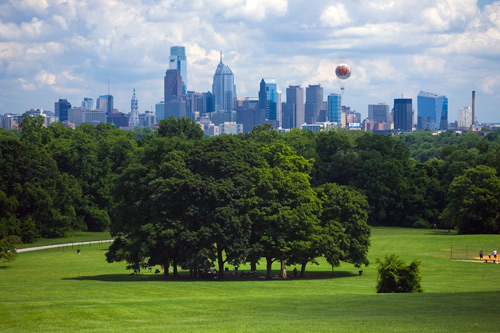
–B Love
|
29 June 09: The 44 report
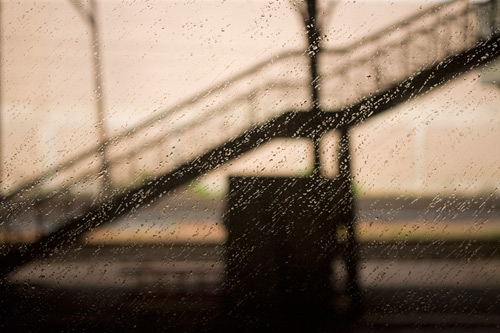
TYRONE → HUNTINGDON → LEWISTOWN → HARRISBURG → ELIZABETHTOWN → LANCASTER → DOWNINGTOWN → EXTON → PAOLI → ARDMORE →
PHILADELPHIA.
Most of the people I meet for the first time here have never heard of my hometown Tyrone, Pennsylvania. I suppose that's fair since it's a town of 5,000 people nestled on the
edge of the Allegheny Plateau somewhere between Altoona and State College, both of which a surprising amount of people don't know, either. (Seriously? State College? Penn State
University?) Many who do know Tyrone recognize it as an old flag stop on Amtrak's Pennsylvanian route, and before that the Three Rivers.
That old flag stop is still there, even if the platform consists of only a concrete space about 12' x 6' and a three sided plexiglass shelter. There is a "station" there -- the
Tyrone Historical Society's museum -- but for some reason, the society and Amtrak were unable to coordinate and have
the large platform with overhanging roof used for the train. Instead, the "station", complete with an old fashioned "TYRONE" sign mounted to its pitched roof, is separated from
the actual Amtrak pickup by a chain link fence and "no trespassing" sign. So frustrating.
Anyway, I started my life in Philadelphia in November 2000 the minute I stepped off the 44 train and came up the escalator to the now familiar din of 30th Street Station. (That
same night, I had a cheesesteak from Dalessandro's and went to a Roots/Jazzyfatnastees concert at the Electric Factory. Hello, Philly.)
Since then, I've taken that same train dozens of times, and almost every time it's been a pleasant ride. The record is imperfect for the occasional overbooking when one has to
sit on one's suitcase and bags in the aisle (if my ticket says "reserved" why do I not have a seat reserved?), and for the occasional seating next to the bloated moron
in Champion shorts and ragged golf shirt who feels the need to talk on his cell phone from Lancaster all the way to Philadelphia (still talking on it when the rest of
the passengers detrain).
On the whole, though, I love riding Amtrak, and I love arriving at 30th Street Station. I've been to most of the major Amtrak stations in the country, and only LA's Union
Station comes close to the sheer greatness of 30th Street. (NYC's Grand Central Terminal may be considered the grandest train station around, but it's a local transit center
only -- Amtrak in New York is at the awful blob of basement hallways called Penn Station.) Chicago's Union Station is nice enough, designed by the same Graham, Anderson, Probst
and White that designed 30th Street (and a number of landmark Chicago buildings including the Wrigley Building, the Merchandise Mart, Shedd Aquarium and Field Museum), but its
main concourse is half the size of 30th Street's, and the Philly terminal has a breathtakingly high and distinctive ceiling.
This ceiling's character was detailed by Patrick Rapa for a cover story he did for City Paper in March 2000 that's like a distant relative to the Independence Pass project Philly Skyline did, The Rail World, 24 hours on Septa.
Staring up six stories will give you reverse vertigo. The ceiling is a geometrical redundancy, squares inside of squares inside of squares, all beside more of the
same. A single blue, stringless, heart-shaped balloon rests up there in one of the squares and waits to deflate.
I found a copy of this issue among some of my things in storage in Tyrone over the weekend. For some reason I'd held onto it from a visit to Philly during spring break in 2000.
(Some went to Jamaica, some went to Cancun. I went to Philadelphia.) Sinking into Rapa's story with my fourth tribute playback of Thriller on my headphones stole me away from
Chatty Charlie the Champion Shorts Guy. Rapa's story reads like a stream of consciousness jotted down on a notebook while riding the train. I jotted down a few notes of my own
as the 44 rambled on . . .
• 3/9/00 City Paper is 120 pages; last week's was maybe 56?
• I hope Lidge closes this game before I lose reception. (He did.)
• I wonder how many people know there's a miniature Statue of Liberty in the Susquehanna River.
• $3.50 for the cheese-and-cracker pack is the best bargain on Amtrak's café car: two 3-packs of Carr table water crackers, two 2-packs of Nabisco Wheatsworth, two
Mini Babybel balls of gouda wrapped in wax, one Tillamook medium (orange) cheddar, one Cabot sharp (white) cheddar.
• $4 Yuengling Lager is so cold it tingles going down.
• The business class' bathroom stinks worse than coach class' and has gnats.
• Good lord how long are we gonna be in Harrisburg? (Long enough to take the rain soaked shot at the top of this post.)
• The conductor smells like sliced red bell peppers.
• Coatesville's steel plant is HUGE.
• Do we really have to stop in Downingtown, Exton, Paoli and Ardmore on the way to 30th Street? They may be old Main Line towns, but with Septa's
redundancy, I think the Main Line can have one Amtrak station and be done with it.
• Finally . . . home.
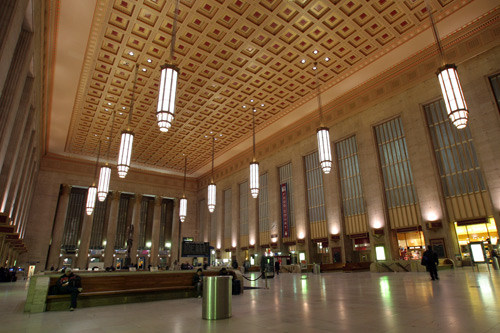
–B Love
|
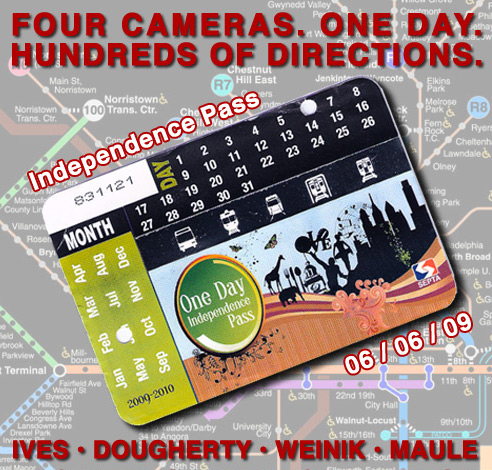
26 June 09: Medley for Michael
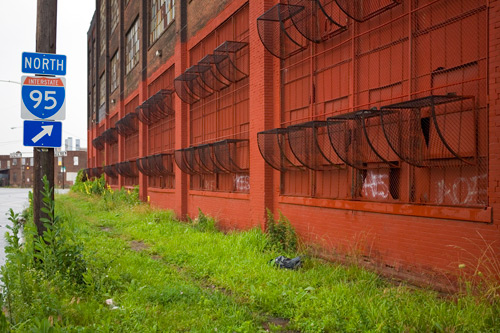
There's some truth to this photo. The building to which the sign points will in fact soon be I-95. The William Cramp & Sons Machine and Turret Shop is all that
remains of what was once the nation's largest shipbuilder, right here in Philadelphia on the Delaware Riverfront.
The building, from about 1905 with 'butterfly roof skylights' (which were patented by Port Richmond's Lupton Company and which maximized natural light, said to improve
work ethics), is slated to join the neverending list of Philadelphia's significant-but-not-significant-enough buildings that were too old and in the way. Cramp's Machine
and Turret shop has an address of 2050 Richmond Street, but it is really just about the exact spot where Richmond, and Delaware, Girard and Aramingo Avenues all
intersect . . . and that's why it's coming down.
PennDOT's pre-stimulus plans to widen I-95 from Center City to Port Richmond include a total reconfiguration of the Girard Ave interchange. The end result will be
better for traffic flow, but the final vestige of another industrial power will be laid to rest because of it.
CDoc has a nice write-up of the building following a visit he and I and about 30 others made to it with the Oliver Evans chapter of the Society for Industrial
Archaeology last Saturday, his piece HERE. Check out the Dallin Aerial
Survey Company's photo circa 1939 HERE
-- the Machine and Turret Shop is the long, dark building on the far left of the picture.
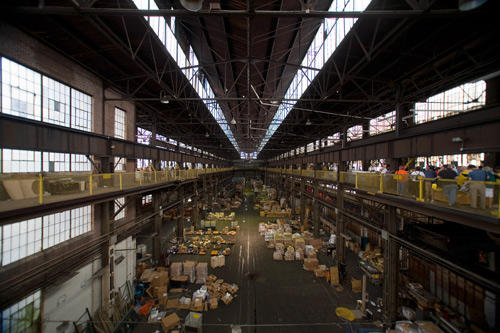
* * *
Just downriver from that place where history's being paved over is another enthralling scene where history has already been paved over, and will soon be even more
paved over. On Wednesday, the Planning Commission held a special session to vote on the Sugar House Thing's amended plan -- the "interim" term and its "subsequent" phases -- and approve it they did, by a vote of 4-2. Tom Walsh has the whole story
on Plan Philly HERE.
Commissioners voting for those amendments were Joe Syrnick, Nilda Ruiz, Peggy Van Belle (representing city Finance Director Rob Dubow) and Anuj Gupta
(representing city Managing Director Camille Cates Barnett).
Those voting no were Natalia Olson de Savyckyj and Nancy Rogo Trainer.
So to you, my dears Natalia and Nancy, thank you kindly for seeing this for the piece of shit that it is. It is a piece of shit, no-name casino, it is a piece of shit
plan with phases that have no guarantee of making it past the enormous "interim" surface parking -- with more surface parking planned for the lot just north of the
main lot and more parking at the Festival Pier lot seen in the photo just below and a gargantuan parking garage that will precede any further phases -- it is a
piece of shit building with piece of shit slots machines (though hey, table
games are finally coming through the Harrisburg pipeline, wheeeee!), and it's all backed
by the piece of shit -- and totally shocking! -- news story that
Ed Rendell, Vince Fumo, John Perzel and John Street accepted over $4.4M in campaign money from casino interests, over a million of it to the Governor alone.
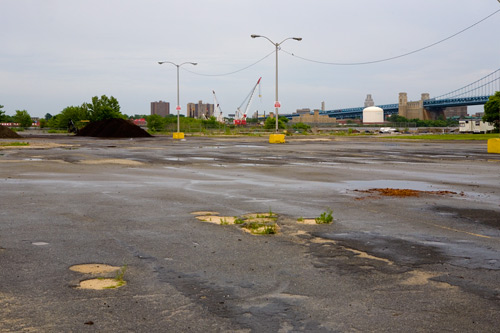
Picture the future, friends. Envision hundreds of cars parked here. They symbolize your riverfront's growth. They represent infinite magic money, tax revenue that
will finally lift Philadelphia's financial burden. Philadelphia, friend of Detroit, ally of New Orleans, brother of St Louis, fair casino cities one and all. Recreate
on your river. Lie your head on the macadam and dream.
Also from Walsh's story on the meeting, architect Ian Cope of Cope Linder:
"Our new approach to the overall plan is decidedly more urban than suburban," Cope said.
And if he says it, it just must be true! As well, the sky is green. Up is down. Iran is a stable country with a bright future.
Those who voted in favor of this SHT on behalf of the Planning Commission claim to have done so with a long view -- that the farther out phases justify the interim
phases. But does anyone honestly believe this thing will get past the interim phase? Does anyone believe there is genuine incentive for it to?
The whole Sugar House Thing is awful, every last thing about it. It's a crappy little slots barn, it's ugly, it has acres and acres of surface parking on site, has
acres of more surface parking off site approved, has acres more still earmarked for farther off site, and as it's presented, it goes against every principle used for
the forward progress of the Delaware Riverfront. Yet for some reason, Mayor Street Nutter, Deputy Mayor For I'm Getting The Hell Out Of Here Andy
Altman, and four-sixths of the voting Planning Commission seem to think it's a good idea.
If I might speak so academically about it: what the fuck ever.
* * *
Hey, while we're here on the Delaware Riverfront, let's take a dip down to Chester. While it's no secret I'm about as pro-Major League Soccer as I am pro-Sugar House,
a couple recent developments have warmed me up to it a little, as have a number of people who've emailed me -- thanks for carrying on a civil discussion, and I
guarantee I'll take you up on a trip to a game at Chester Stadium next year . . . provided it's open by then!
Earlier this week, the US stunned Spain 2-0 to advance to the finals of the Confederations Cup and face Brazil, the team that defeated the US twice on its own soil the
only time it hosted the World Cup. That the US is in the final is a testament to the underdog, so go America go.
And in today's PBJ, Natalie Kostelni and John
George report that the development team building the stadium in Chester has secured $25M in private funding (in addition to the $77M of public money already spoken
for and the loan from Sovereign Bank to help build it), with hopes to break ground on an office building this year. That's a pretty good retort to the thought that
none of the spur development from the stadium would ever happen, so here's hoping they carry through with it.
* * *
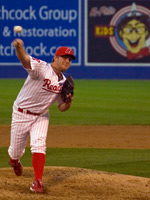 Skipping back up to the other riverfront, the Schuylkill -- the one whose Philadelphia development corporation is headed by Joe Syrnick, one of the four Planning
Commissioners who voted to approve the Sugar House Thing's amendments -- we're gonna take it way upstream, past the Fairmount Dam, past East Falls and Manayunk, way up
past Conshohocken and Valley Forge to a little place called Baseballtown USA. The Reading Eagle reported last week that Baltimore's Giannasca Development Group has proposed a $2.8B transformation of Reading's Schuylkill Riverfront in concert with the
city itself.
Skipping back up to the other riverfront, the Schuylkill -- the one whose Philadelphia development corporation is headed by Joe Syrnick, one of the four Planning
Commissioners who voted to approve the Sugar House Thing's amendments -- we're gonna take it way upstream, past the Fairmount Dam, past East Falls and Manayunk, way up
past Conshohocken and Valley Forge to a little place called Baseballtown USA. The Reading Eagle reported last week that Baltimore's Giannasca Development Group has proposed a $2.8B transformation of Reading's Schuylkill Riverfront in concert with the
city itself.
One of the components would be a new ballpark for the Reading Phillies, the AA affiliate of our hometown WFCs. This bit is curious, though, as FirstEnergy
Stadium -- a classic since 1950 that has seen such greats as Mike Schmidt, Greg Luzinski, Ryne Sandberg, Pat Burrell, Chase Utley, Ryan Howard and Cole Hamels pass
through its stiles -- was rated by Baseball America as the best AA ballpark in
America, third best minor league park overall. In other words, that ballpark ain't broke, so there's no need to fix it, even in the name of improving Reading's forlorn
riverfront.
The picture here, by the way, is of the Phillies' top 2006 draft pick, Kyle Drabek (and, uh, the R-Phils' crazy hot dog vendor). The son of the former Pittsburgh
Pirate Cy Young winner Doug Drabek is kicking serious tail in Reading and was named to the Futures Game, the prospects all-star game during the Major League's
all-star game, this year in St Louis. Go 'head, Kyle, and keep mowing em down. (For some more of my photos of the R-Phils' 5-4 win over the Yankees' AA Trenton
Thunder from a couple weeks ago, check out the post at The Fightins HERE.)
* * *
Speaking of the Phillies . . . ugh. Let's actually not talk about the Philadelphia Phillies right now. Unless Ruben Amaro actually goes out and gets us a new
starting pitcher or -- at this point, hey why not! -- calls up Kyle Drabek just like Pat Gillick called up Kyle Kendrick a couple years ago. Somehow I think Drabek's
got a little more in him than KK did, even if it takes a while to establish. We've been waiting on Carlos Carrasco to be the future for what, three years now? Joe
Savery's doing a heck of a job keeping Drabek company in the win column in Reading, too. Let's hope the big league Phils are able to right their ship and stay there,
too. WAKE UP, JIMMY!
* * *
Oh! The Philadelphia Independent Film Festival kicked off last night and is in high gear this weekend. With a familiar foothold in the Northern Liberties, PIFF 2009
features dozens of independent films, many local, across several screens in the area. Show em some love and check out the web site HERE.
* * *
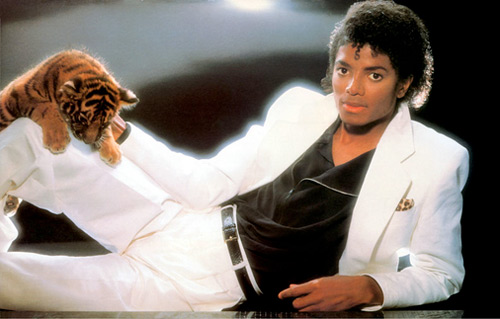
(Centerfold from Thriller, 1982, Epic Records (OBVS))
Finally, an RIP addendum to yesterday's farewell to Steven Wells and Irv Homer. The King of Pop is dead at 50 . . . wow. He was a large part of my 80s childhood, a
large part of another generation's childhood in the 70s, and even a part of the 60s revolution as a child star. His final decade-plus were filled with trouble that all
stemmed from his own insecurity, and it's really one of the great American tragedies. Say or think what you will about him, but you can't front on the only person in
music history to sell more than 100 million copies of a single album, 1982's Thriller. Bad (1987) sold 30 million, Dangerous (1991) sold 32 million, Off the Wall
(1980) sold 20, and his 1994 hits package HIStory sold 20 million . . . the numbers don't lie. That man was bad. Really, really bad!
Later, Mike.
–B Love
|
25 June 09: For your consideration
25 June 09: Circle of life
 Philadelphia has lost two voices on this day, one of a grumpy old man and one of a grumpy young man. I did not know the writer Steven Wells (of the Philadelphia
Weekly, and back home in the UK at NME and the Guardian) or the barman turned radioman Irv Homer (who I knew better as a regular on 6ABC's Inside Story)
personally, but I knew them in my Philadelphia experience.
Philadelphia has lost two voices on this day, one of a grumpy old man and one of a grumpy young man. I did not know the writer Steven Wells (of the Philadelphia
Weekly, and back home in the UK at NME and the Guardian) or the barman turned radioman Irv Homer (who I knew better as a regular on 6ABC's Inside Story)
personally, but I knew them in my Philadelphia experience.
Both men were extremely opinionated, and that's why we knew them and loathed them and loved them. Wells' often smarmy pieces for the Weekly seemed to take aim at
otherwise unsuspecting targets (the hipster episode from a couple years back in particular stands out), but at the end of his say you couldn't tell if you were
mad at him for saying such a thing or at yourself for tending to agree, for some reason. His public fight with cancer was pretty topical in my personal circle
(and especially my wife's personal circle) and did well to lend a different perspective to such a shitty situation. His farewell column in the Weekly, online HERE, will no doubt make the
rounds -- of outspoken journalists, cancer fighters, admirable Philadelphians -- as it well should.
I wasn't around to hear Irv Homer in his WWDB heyday, where on occasion his talk radio show would bomb, making him angry to a point of literally reading the
phone book over the air until someone called to tell him to knock it off and start a new conversation. Irv Homer to me was the animated old crank seated at
Monica Malpass' right on Sunday mornings, the libertarian shooting from the hip and not really apologizing to whomever he nipped in the process.
Steven Wells, dead at 49. Irv Homer, dead at 86. Peace out, dudes.
–B Love
|
24 June 09: Skyscrapers is grand
 This photo of the PSFS Building was included in the Philadelphia Museum of Art's press release for the exhibition that just opened called Skyscrapers: Prints, Drawings, and
Photographs of the Early Twentieth Century. . . . and I wondered why. As someone who's spent a great deal of time photographing, drawing, and studying skyscrapers in nine
years of living in a city with a good many skyscrapers, I've developed my own set of criteria for what makes a good image of a skyscraper. It's not academically (or Art
Institutionally) approved, it's just what I see and know and like and use. This one, made by Philadelphia photographer Lloyd Ullberg in 1933, is off balance, lacks the contrast
that's nowadays as easy as sliding the points of a Photoshop histogram, and doesn't really tell anything about its subject. That's exactly what makes it work in this
exhibition.
This photo of the PSFS Building was included in the Philadelphia Museum of Art's press release for the exhibition that just opened called Skyscrapers: Prints, Drawings, and
Photographs of the Early Twentieth Century. . . . and I wondered why. As someone who's spent a great deal of time photographing, drawing, and studying skyscrapers in nine
years of living in a city with a good many skyscrapers, I've developed my own set of criteria for what makes a good image of a skyscraper. It's not academically (or Art
Institutionally) approved, it's just what I see and know and like and use. This one, made by Philadelphia photographer Lloyd Ullberg in 1933, is off balance, lacks the contrast
that's nowadays as easy as sliding the points of a Photoshop histogram, and doesn't really tell anything about its subject. That's exactly what makes it work in this
exhibition.
Skyscrapers, which officially opened at the PMA on June 6th, is not a study of architecture, though it has some architectural drawings -- including one that transcends
Ullberg's photo into an incredible work of art. "The PSFS Building", an etching by Earl Horter from 1932, exhibits the clean lines and crispness of the tower's celebrated
modernism, a contemporary artwork of the tower George Howe and William Lescaze had completed that same year. Horter's labored work of art appears realistic; Ullberg's instant
snapshot is shockingly abstract.
Ullberg's selection is therefore no mistake. Curator John Vick chose the image from the PMA's permanent collection of prints, drawings and photographs, which is comprised of
over 170,000 pieces. "The Horter image captures the moment of the building -- the style speaks very much of 1932," Vick says. "Ullberg's is a complete contrast, a much more
conceptual image when photography was just beginning to be able to do this."
If any one person can be traced back to as a forebear of photography as art, it might as well be Alfred Stieglitz. PMA's center of photography bears his name, and his
portraits of a young Georgia O'Keeffe (who quickly became his lover, and later, wife) pushed the boundaries of accepted photography, its sensual nature helping to launch her
own career. (Another interesting footnote: Ansel Adams, perhaps the most famous of all American photographers, made visits to O'Keeffe at the New Mexico ranch where she made
her most recognized works of art.)
Stieglitz moved with his family in 1881 to Germany at the formative age of 17 and immediately became obsessed with photography. When he returned to New York in 1891, art
museums were for the most part still not collecting photography, and a lot of the photography competitions and exhibitions of the day were judged by established artists --
painters, lithographers and such. In the decade leading up to the turn of the century, he became the editor of American Amateur Photographer, the leading journal on the
subject, he helped to form the Camera Club of New York and its own journal, Camera Notes, and he was laying the foundations for what would become the Photo-Secession, a
group of artists dedicated to the advancement of photography (who borrowed their name from a show of prints called The Secessionists and which included Henri Toulous-Latrec and
Edvard Munch). All the while, his hometown -- the epicenter of American art -- was his muse; his work rose with the rising city around him.
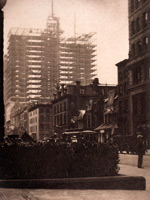 New York at the turn of the century witnessed explosive growth of the maximization of usable space, the technologically assisted vertical growth of the city; Stieglitz' camera
witnessed New York. "Old and New, New York", from 1911 (pictured at left), is one of three pieces by Stieglitz in Skyscrapers and exemplifies the early fascination with
newfound building enormity, the construction of the Vanderbilt Hotel rising over its lowrise neighbors. Another mounting, "Looking North from An American Place", is a series of
three photos from 1930 showing the construction progress of the New York Trust Company Building and Pierre Hotel. Alfred Stieglitz was doing in New York a century ago what this
web site has done in the two thousand oughts.
New York at the turn of the century witnessed explosive growth of the maximization of usable space, the technologically assisted vertical growth of the city; Stieglitz' camera
witnessed New York. "Old and New, New York", from 1911 (pictured at left), is one of three pieces by Stieglitz in Skyscrapers and exemplifies the early fascination with
newfound building enormity, the construction of the Vanderbilt Hotel rising over its lowrise neighbors. Another mounting, "Looking North from An American Place", is a series of
three photos from 1930 showing the construction progress of the New York Trust Company Building and Pierre Hotel. Alfred Stieglitz was doing in New York a century ago what this
web site has done in the two thousand oughts.
Several New York buildings of the day -- Flatiron, Woolworth, Singer, Chrysler, Empire State -- and a handful of Chicago ones -- Wrigley, Tribune --
are spectacular subjects here as art, as much as they are spectacular examples of modernity, architecture and engineering achievement. "I didn't want it to seem that this was a
New York or Chicago-centric exhibition, but any show about early skyscrapers will naturally find common ground in these cities [as pioneers of the skyscraper]," Vick explains.
He then points to "Shells of the Living", an aquatint from 1933 by Benton Spruance of a building we know as Philadelphia's own PNB Building. Depicting a chaotic, yet rhythmic
urban scene, the print puts One South Broad in the background of fire escapes, exhausts, billowing smoke, and way down on the ground, a big truck, maybe a garbage truck.
One of the most powerful, and playful, pieces in Skyscrapers is from neither New York nor Chicago nor Philadelphia. Thurman Rotan's "Horse and Skyscraper" shows San
Antonio, Texas in a spaghetti western view of manifest destiny, a giant stone building rising over a horse at a pond in a meadow, a comical progress-over-nature. It's a
noticeable silliness in an exhibition whose other parts portend fear from the stock market crash of 1929, twinkling fascination of the new nighttime skyline, and hope for the
future out of the desolation of the Great Depression.
And all of these come from the observation of skyscrapers. Buildings leapt and charged ahead; art kept pace.
Stieglitz and his friends, photographer Paul Strand and painter John Marin, are among those exhibited in Skyscrapers. Berenice Abbott's Changing New York was one
of the most influential early photography exhibitions, funded by Franklin Roosevelt's Federal Art Project, and is revisited with a number of her photos here as well. All
told, there are 55 works in the show.
Skyscrapers: Prints, Drawings, and Photographs of the Early Twentieth Century is in the Berman Gallery on the ground floor of the Philadelphia Museum of Art. It's open
now and runs through November 1st. It's curated by John Vick, the Margaret Mainwaring Curatorial Fellow in the Department of Prints, Drawings, and Photographs, a two year
fellowship that concludes with an exhibition of the Fellow's choosing. Skyscrapers is Vick's exhibition.
For more on the show, visit PMA's web site HERE.
–B Love
|
24 June 09: Train of Thought
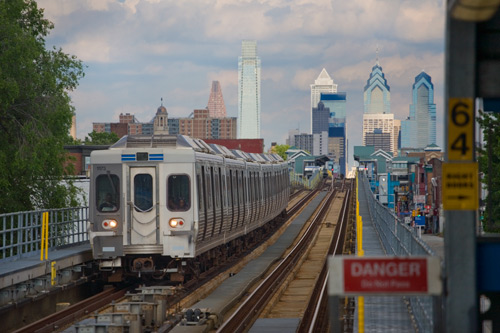
by Steve Ives
June 24, 2009
There are many things in our daily lives that we really don't give much thought to. Simply by habit, most of us take for granted that our days are going to follow a simple and
reliable pattern; we get up, prepare, commute, work, eat, leave, workout, socialize, check email and go to bed so that we can repeat the process again the next day and the day
after
that. Rarely do we consider the possibility that our daily routine can be thrown completely out of whack in an instant.
The tragedy in Washington, D.C. on Monday made me consider that possibility. Transportation has to rank among the most mundane aspects of our daily lives. 99 days out of 100
our train or bus arrives or our car starts and we may encounter the unwanted but not totally unexpected delay and beyond that we really don't think about how we travel much.
It's a necessary part of the day but, like any other part, one we may only give more than a moment's notice to when something goes wrong. The other night I was chatting with
Brad and some friends when the topic of
the derailment came up and I shared a quick anecdote about my only experience with anything like it.
On March 7, 1990, a westbound El train derailed heading out of 30th Street station, killing four and injuring 158 people. Though I was only seven years old at the time I
remember how much news coverage it got and it was probably the first time I'd ever processed the thought that something like that could happen -- that a train, something that
widens the eyes of any seven year old boy, could come off of its track and hurt the people inside.
The El had certainly been a familiar part of my life up to that point. On weekends, my mom would take my little brother and me into town to see a movie, to buy clothes for my
frightfully fast growing frame or simply just to get out of the
house, and our preferred method of transportation had been the old, loud, rickety El with its odd green-and-orange wall panels and, as I used to call the fan vents on the old
M-3 cars, "four hats". It was fun riding the train. My brother and I would fight for the window seat, we made all kinds of excited noises when the train would go momentarily
dark after leaving the third rail going over a switch. Little kid stuff.
But I remember the time of the train crash. I remember my mother's words that suddenly riding The El, which had
carried millions of people all along its route in its 83 year history at that point, was not safe. She never took us on the train again for a family weekend. We suddenly became
very familiar with the bus and the whole concept of the train faded out of my memory a bit.
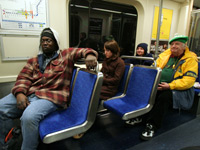 Because of mom's prohibition, I didn't set foot on The El again for three years until I started going to school in Center City and quickly realized that there were fewer red
lights under Market Street than there were on Chestnut Street and for a few months silently violated my mother's prohibition on riding that dangerous El -- sometimes to
the point of lollygagging downtown just so I wouldn't get home too fast and have her think I'd been riding it instead of the bus. The subterfuge ended not too long thereafter
on a day when I was really running late for school and Mom told me, "just take the train," to which I replied "I already have been."
Because of mom's prohibition, I didn't set foot on The El again for three years until I started going to school in Center City and quickly realized that there were fewer red
lights under Market Street than there were on Chestnut Street and for a few months silently violated my mother's prohibition on riding that dangerous El -- sometimes to
the point of lollygagging downtown just so I wouldn't get home too fast and have her think I'd been riding it instead of the bus. The subterfuge ended not too long thereafter
on a day when I was really running late for school and Mom told me, "just take the train," to which I replied "I already have been."
I think I've logged more hours on The El in my life than many pilots do in the air. I've never owned a car and have never had a job or a friend or a free drink that The El
couldn't carry me to. It's as much a part of my daily routine as tying my shoes. I've ridden over the spot of the 1990 derailment hundreds, if not thousands, of times by now
and I've given thought to that incident when I've been in that area maybe four or five times. Usually, I'm thinking about where I'm going or where I'm leaving, I'm listening to
music, chewing gum, doing sudoku -- doing what people do on the train: not thinking about being on a train. You, me, millions of people across the country doing what we do
everyday and never thinking about it until we're not doing it anymore.
–Steve Ives
phillytrax@aol.com
For Steve's archives, please see HERE.
|

23 June 09: Summer solstice remix
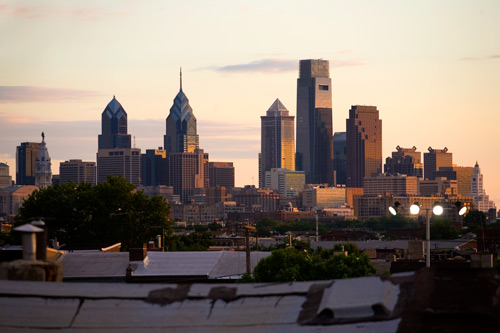
How the hell can I make my teammates better by practice?
This practice photograph was made on Saturday evening, the summer solstice, the longest day of 2009. This time of year is good fun for photographers, the early morning and late
day sun splashing its magic hour sunlight on the north sides of buildings that don't get it for four-fifths of the year.
–B Love
|
22 June 09: A lovely evening for sailing, the photo essay
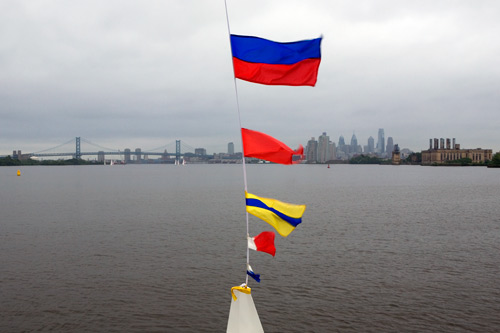
As promised, here it is, Monday at the latest.
Thursday night, Penn Design offered a three hour tour (a three hour tour) of the Delaware River and a platform for the school's clinical arm, Penn Praxis, to showcase its civic
vision. Executive director Harris Steinberg rocked the mic from roughly Allegheny to Oregon -- the subject area of the plan -- and Captain Lucky's SS Ben Franklin sailed a
hundred or so of us including Olin landscape architect Cindy Sanders, former Planning Commission director Craig Schelter, Penn Treaty Park (and online Museum) guru John Connors, Claflen Associates principal George Claflen Jr, stowaways like myself and lots of Penn
people from the marina at Dave & Buster's up to the Betsy Ross Bridge and back down to the Navy Yard before returning to dock. Harris' son Henry was along for the ride, and
his photos have been posted at Plan Philly HERE.
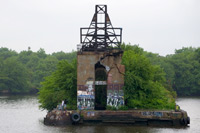 This morning's post on the Conrail-Anderson yards on the Port Richmond-Kensington riverfront was pretty timely, if unintentionally timely. Tom Walsh -- who was also on the
cruise -- reported last week that Anderson's former Cramp site was being readied to go to market. The ~60
acre vacant site, next to the 200+ acre vacant Conrail site, and just up from the still-vacant but active 22 acre Sugar House site, were all major items of interest fresh out
of the dock. As was the nearly 400 acre Petty's Island, recently donated to the state of New Jersey from Venezuela-owned Citgo, directly across the river from Anderson and
Conrail.
This morning's post on the Conrail-Anderson yards on the Port Richmond-Kensington riverfront was pretty timely, if unintentionally timely. Tom Walsh -- who was also on the
cruise -- reported last week that Anderson's former Cramp site was being readied to go to market. The ~60
acre vacant site, next to the 200+ acre vacant Conrail site, and just up from the still-vacant but active 22 acre Sugar House site, were all major items of interest fresh out
of the dock. As was the nearly 400 acre Petty's Island, recently donated to the state of New Jersey from Venezuela-owned Citgo, directly across the river from Anderson and
Conrail.
Thursday, you'll probably recall, was one of the approximately 64 consecutive days of cloudiness and outright downpour. It did that for parts of the cruise, turning the River's
surface into a gray Pollock canvas in motion; for the rest of the ride, the sky turned grayer and darker as the daylight dwindled. A challenge for the photographers on board,
but a welcome one, considering any reason to board a boat on the Delaware is a good one.
These are my efforts -- 79 photos spread across eight pages. Hope you enjoy.
BEGIN.
–B Love
|
22 June 09: Dreaming on the Delaware
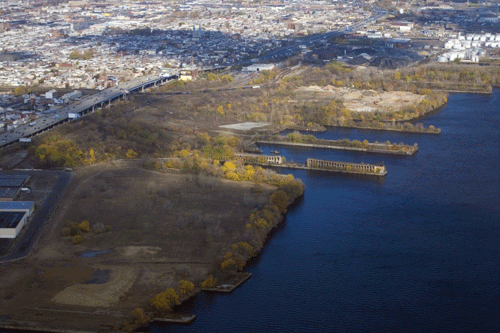
Here's a short timeline. In November 2006, Penn Praxis held the third of three tours for the public along the Central
Delaware Riverfront whose redevelopment Mayor John Street had charged them to lead (based on the efforts of Councilman Frank DiCicco and his aide Brian Abernathy). Praxis
executive director Harris Steinberg conducted the walk with Planning Commission executive director Janice Woodcock, Mayor Street, State Representatives Mike O'Brien and
John Taylor, Paul Levy and others, heading from Penn Treaty Park to Pulaski Park via the former Cramp's Shipyard and former Reading Railroad lands. In September 2007, CDoc and I focused in on the Reading yards, over 200 acres of post-industrial emptiness now owned by
what's left of the Conrail corporation. A month later, October 2007, some of this site's readers
offered up their thoughts on how such a vast amount of riverfront land could be re-imagined. In September 2008, I got an email from a Drexel student named Trevor Booz
saying he and some of his classmates were considering doing their senior project in the Department of Civil, Architectural and Environmental Engineering on Conrail's
property, and would I give them a hand. In June 2009, Trevor Booz, Erica Leeds, Kyle Jones, Tom Donnelly and Rick Antoine walked the stage at Drexel as members of the
newest graduating class with a senior project marked with an A+ tucked in their back pocket.
The nine months that passed between found the five students on site in Port Richmond, countless hours in the university's and city's libraries, and at least once, in the
office of the (new) executive director of the city Planning Commission. Applying their education and expertise in areas of structural engineering, HVAC, architecture and a
collective environmental awareness, Team 8 set out to breathe new life into Conrail's riverfront property -- within reason. As I mentioned in my guest column in today's Metro, dreaming up dreams for enormous, open, adjacent properties --
Conrail's, Anderson's and PECO's properties add up to nearly 300 contiguous acres of potential -- can be intoxicating. So credit where it's due: Drexel's engineering
department appreciates your dreams, but expects them to be ground in reality.
Rather than spend a full school year envisaging a starry-eyed, billion dollar Philatopia with seamless gateways to Kensington and North Philadelphia via the Lehigh
Viaduct and an effective ferry system to Palmyra Cove, Petty's Island, Penn's Landing and Camden, Team 8 devised a reasonable plan for a reasonable chunk of it, 38 acres,
based on a series of objectives: economic improvement, environmental impact, transit accessibility, fitting the Civic Vision for the Central Delaware Riverfront, and
financial feasibility. Projected LEED items included effective stormwater management, the use of local materials, brownfield reclamation by the site's reuse, low energy
practices, and in a specific example, recycling unsalvageable concrete from Pier 18, the McMyler Coal Dumper.
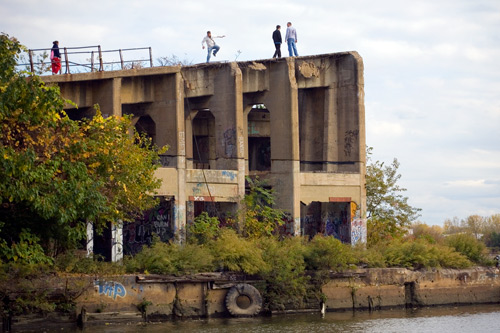
The Coal Dumper -- or the Ore Pier, if you like -- is the de facto symbol of this entire stretch of morose riverfront. Nearly everything that once made the 20-some piers
between Allegheny Avenue and Berks Street the marine sector of the Workshop of the World is gone. The 145' Port Richmond Elevator, Cramp's dry docks, even most of the rail
network that fans from Lehigh out to the many
piers . . . it's all gone. But the Coal Dumper, dormant for decades, still stands as a testament to reinforced concrete. Its swooping mechanism once unloaded Pennsylvania
coal from Reading Railroad cars, one by one, onto outbound ships. At work, the apparatus looked something like THIS.
A fortress of feet-thick walls and manufactured symmetry, the Coal Dumper may well be unknown to the majority of modern Philadelphians, but to industrial historians, off
roaders, graffiti artists, paintballers and neighborhood teenagers with a case of Natty Light, it's hallowed ground. To Team 8, the Coal Dumper is a necessary
centerpiece.
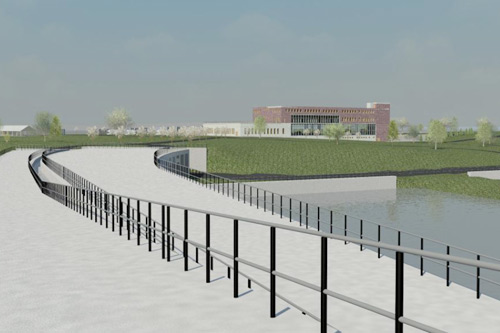
The first consideration for the site was a reindustrialization, but with the Port of Philadelphia's efforts focused on Packer Avenue's expansion into Southport, and with
the planned deepening of the ship channel ending a mile south at the Ben Franklin Bridge, Team 8 opted for a softer use, with the potential for steady revenue in a more
academic avenue. In the 3D rendering above, the viewer looks from the top of the Coal Dumper toward a new Museum of Industrial History. In it are artifacts from the city's
industrial heyday -- Reading Railroad engines, Stetson hats, Globe Dye fabrics -- and interpretive and educational programs to explain them.
While a new museum would need a new non-profit organization that would rely on new donations, the office space the building shares would not. Rentable office and retail
space provide the opportunity for companies to relocate to an attractive new riverfront location and provide the park a steady, annual revenue. A cafeteria akin to that at
Urban Outfitters' Navy Yard headquarters ties the tourist sector and office sector together in a common space.
The main entrance to the park, the intersection of Lehigh Avenue and Richmond Street, is effectively the backdoor to a site whose front face is several acres of Delaware
Riverfront. The straphanger arrives via the 15 trolley, the 54 bus and the 43 bus, all of which have a loop off of their regular Richmond and Lehigh routes. The motorist
pulls in only as far as the parking lot, oriented on the Richmond Street side of the parcel to maintain the riverfront's openness. The cyclist arrives on the northern and
southern ends of the park via the East Coast Greenway, passing from Maine to Florida right through the Delaware River's newest park. The pedestrian comes as he or she
pleases, with several points of access.
A large playground is located near the parking lot for parents who are busy. A modest, grassy amphitheater is landscaped and recessed for visitors who are anything but
busy. On the wide pier one over from the Coal Dumper, a year round catering facility accommodates large parties for weddings, bar mitzvahs and Christmas parties, right on
the river. Pedestrian pathways connect them all.
Who's going to pay for it? And there is the never ending question. Planning Commission executive director Alan Greenberger lauded Team 8's efforts in a face-to-face
meeting (which, incidentally, was the day his boss Andy Altman dropped his London bomb -- the meeting was after Altman's announcement and just before he and Greenberger had
met to discuss it), but offered some advice for cost analysis, with the wisdom accrued of years in practice: "Take all your estimates and multiply them by four. It's always
more. Money is a wet blanket . . . especially in Philadelphia."
Citing several examples of riverfront projects that never got off the ground, for the sole reason of cost, he stopped to acknowledge a success story: "Bart Blatstein is an
example. If he'd brought the banks his plans for the Piazza, they would've told him to turn around and go home. But he bankrolled his vision and built it."
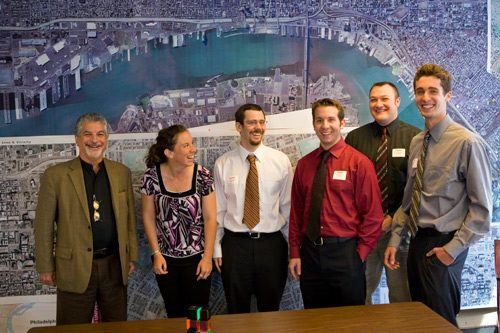
What's so funny about the Conrail Yards? L-R: Alan Greenberger, Erica Leeds, Kyle Jones, Tom Donnelly, Rick Antoine and Trevor Booz.
Whether some wealthy visionary bankrolls a huge post-industrial park on the Delaware River -- nay, whether Conrail Shared Assets would even sell the once powerful site for
such a venture -- is a matter for the future. Whether it could be expanded southward to James Anderson's former Cramp yards, or westward on the Lehigh Viaduct . . . these
are even farther into the future. But for the pesky problem of dollars, there's no reason not to think it has a feasible framework.
To see Team 8's project vision, check out the 21M Powerpoint presentation HERE. (The 300 page appendix
has been intentionally omitted.)
* * *
For more on Port Richmond's industrial history on the riverfront, visit workshopoftheworld.com HERE.
For more on Cramp's shipyard and their role in American Naval might, visit globalsecurity.org HERE.
For some great aerial photos of Port Richmond at work, as always, check out the Dallin Aerial Survey Company at the Hagley Library's web site HERE -- search for "Port Richmond".
* * *
Finally, as the credits roll, a Philly Skyline congratulations goes out to the graduates in this era of awful employment rates for new grads. Trevor's immediate plan is to
go to the University of Delaware for his masters in Civil Engineering with a concentration in transportation. Tom is already working for Vitetta, whose biggest job at the
moment is the Convention Center's expansion. Rick is working at CMX Engineering's Lansdale branch. Erica is already on the 9-to-5 on Market Street at the Burns Group. And
Kyle will be going to Seminary full time in the fall.
–B Love
|

19 June 09: COMING ATTRACTIONS
A lovely evening for sailing
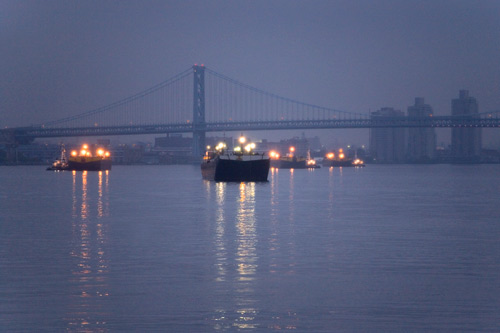
It was at the exact moment that John Mayberry Jr popped out to second with two men on to seal a sweep by the visiting Toronto F'n Blue Jays that I stepped onto Captain
Lucky's SS Ben Franklin last night in a fit of disgust. Lucky for me, the Cap'n keeps a healthy stock of Dewar's behind the bar. Hey, he's Captain Lucky!
The Ben Franklin and the beautiful June weather set the scene last evening for a yachters delight on the Delaware. With at least half a dozen ships
with anchors dropped in the river (presumably to let the storms of the last few days pass), the Ben Franklin took about a hundred guests of Penn Design on a tour led
by Penn Praxis' executive director Harris Steinberg of the riverfront whose future he is guiding.
Look for an essay of around 100 photos (it's gonna be tough to pare them down since there is so much to see from the river) some time this weekend, Monday at the
latest. In the meantime, I'ma get outdoors for this first sunny day since 2002.
Keep it clean this weekend, y'all, and I'll see you down on 2nd Street.
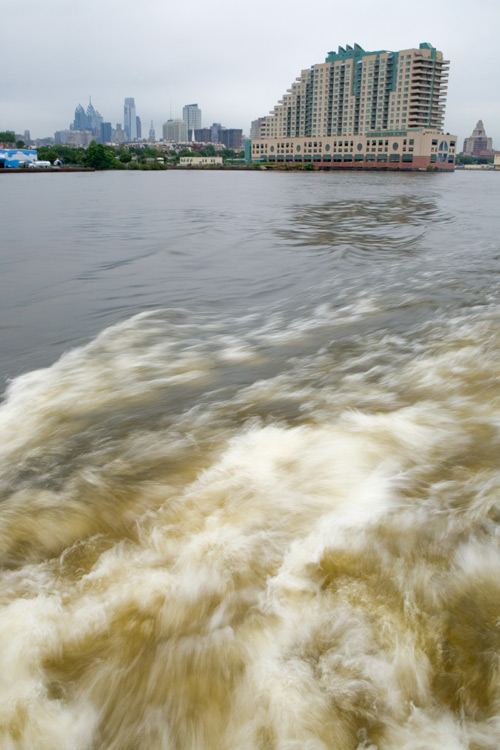
–B Love
|

18 June 09: Dragon ahead
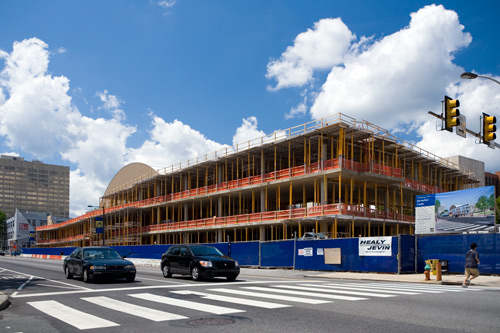
Today's little construction update is going to make like it's not raining, and instead rake in the views on this beautiful sunny make believe day at Drexel University.
Ahh, internet.
The Drexel family lost its figurehead when president Constantine Papadakis passed away at the young age of 63 in April. In his 13 years as president, he helped build
the university back into a successful and innovative technological leader, which is what the Drexel Institute of Art, Science and Industry was founded to be in 1891.
Among the legacies he helped build for the university was the resentment of the likes of Radar Magazine and all the college blogs that dogpiled on them when Drexel was named
ugliest college campus in the country. And they're doing something about it.
We start here on Market Street, just up the street from where the "Drexel University" sign welcomes visitors from a wedge in front of the Firestone auto care shop.
This is the expansion of the existing, and otherwise nondescript, Daskalakis Athletic Center. This expansion, called simply 'Recreation Center', was designed by Sasaki
Associates (who was behind Penn's master plan vision) and Ewing Cole (locally based architects with a strong expertise in sports venues, including Citizens Bank Park
and the Phils' spring training and Single-A Clearwater ballpark).
The Recreation Center will feature an expanded gym, a suspended running track, squash courts and other features. Like most of Drexel's recent initiatives, it's using
green building practices.
* * *
Turning up 33rd Street and swinging back down 34th, we come to the new tallest building on campus.
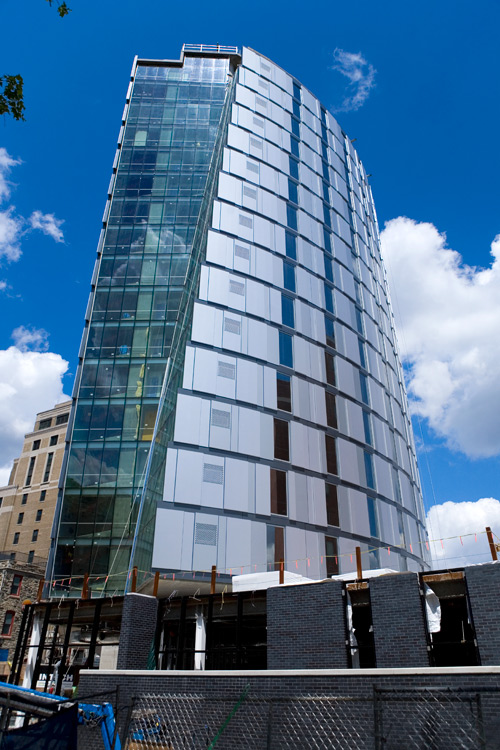
Millennium Hall is a regular guest on Philly Skyline, and now that it's this close to opening, it very well may become a star. The 482-bed dormitory is easily my
favorite of Erdy McHenry's campus projects that also include the earlier Drexel dorm on 33rd Street, Temple's Avenue North and Edge, and Penn's Radian. Now that the
glass is installed on the east and west sides of the football-shaped building, it stands out well on its own, shedding any "for a campus" additives.
What a great looking building, and what a bonus for the Drexel sophomores who get to live in this. The dorm I lived in my sophomore year at Shippensburg -- Naugle Hall
represent! -- resembled a housing project and is slated for demolition.
* * *
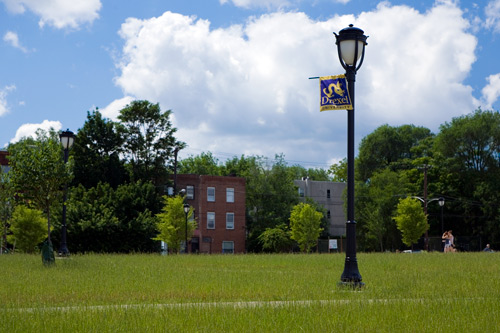
Now, here's Drexel Park. Decades ago, it was the Consolidated Laundry site. A couple years ago, it was a fenced off vacant lot. In October (9 October 08, Presenting . . .), it was a celebrated brownfield reclamation brought on by negotiations
between Drexel, the Powelton Village neighborhood, and councilwoman Jannie Blackwell. A full school year later, it doesn't look any different than it did when it
opened, and by the looks of things, it could use a good lawn mowing.
The less Drexel does to really amp up this jewel of a park, the more it feeds the impression that the park is nothing more than a concession, a holdover until the
agreement expires and Drexel can build on it (whether a dorm, lab, classroom space, or what have you). That's the one cut against Drexel's otherwise calculated
improvements to the campus.
Drexel Park is the bridge between the university and the neighborhood, the gateway to Spring Garden (and the Art Museum / Schuylkill River / Kelly Drive), and the
views of the skyline (and if you're a railfan, the railroad yards) are fantastic. Put in more benches. Install some freaking public art. You've got a great park here,
guys -- it bears your university's name -- accentuate it.
That skyline view . . .
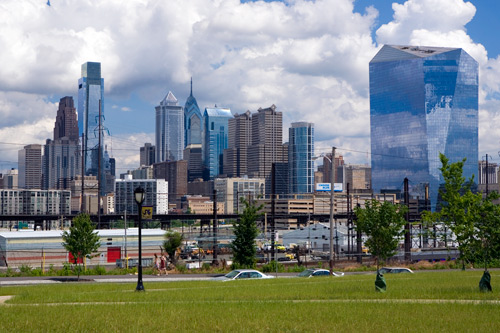
For more on these and other projects, such as the Integrated Sciences Building, visit the Drexel Green web site HERE.
–B Love
|
17 June 09: Pier to pier network
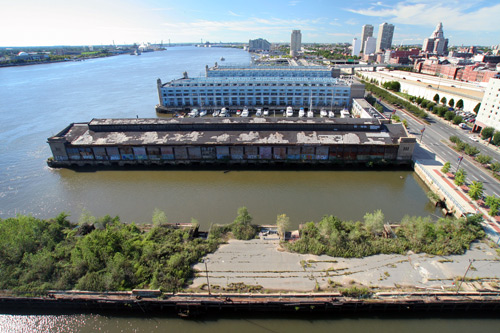
From this view on the Ben Franklin Bridge, we can trace the shapes of the piers and wharfs all the way to the Walt Whitman Bridge like so many teeth on a comb. The one
at the bottom has gotten an awful lot of lip service in the year that's lapsed since the Declaration on
the Delaware, and tonight the city is throwing it its own party.
Ladies and gentlemen, Pier 11. Tonight at 6 at Festival Pier, Mayor Nutter and the Delaware River Waterfront Corporation, the artists formerly known as Penn's
Landing Corporation, will present the designs of their RFP's four Pier 11 finalists, rain or shine.
A quick aside, if I might? Why "Delaware River Waterfront Corporation"? Why not just "Delaware River Corporation"? Or "Delaware Riverfront Corporation"? River
Waterfront. The 'W' is the least necessary of the letters in the acronym, DRWC, and it's the most cumbersome letter in the English language. "DRWC." "DRC." The W
is for WHY? They must have realized this after the graphics and literature were printed, because delawarerivercorporation.org resolves to
delawareriverwaterfrontcorp.com . . . but the registrant is listed as Penn's Landing Corporation, the old corporation. This entire paragraph has made my head
hurt.
But I shall take a couple advil and sup with hizzoner this evening at Festival Pier. His Deputy Mayor of River Waterfront Development Andy Altman is the Chairman of
the Board at DRWC, so if he's at the presentation this evening, be sure to congratulate him on his promotion to London and give him a good luck pat on the butt for the
2012 Olympics.
So Pier 11 then. Of the four finalists to design Pier 11 as our own little Pier A (Hoboken) with breathtaking views of the Delaware River, the Ben Franklin Bridge, and
the decrepit, graffiti covered Pier 9 next to Pier 11, three are from New York City and one -- one -- is from Philadelphia. We're pulling for you, Andropogon -- the odds are stacked 3 to 1 against you, but Philly's all about its underdogs, and it wouldn't be a
Philly project if its native sons weren't the underdogs to win the native project.
Pier 11 is intended to be one of the proverbial crown jewels of the riverfront's redevelopment, largely paid for by a $1M grant from the William Penn Foundation. As
yet, there is no word if any of that money is going to go towards an educational workshop for DRPA cops who are hellbent on harassing people who take pictures of the
giant, beautiful, iconic bridge whose presence overwhelmingly draws your attention to it. It seems unlikely, though, so if/when Pier 11 becomes reality, look for
either 1, signs advising people to not take pictures of the Ben Franklin Bridge, or 2, lots of stories of DRPA cops rolling up on their bicycles, asking tourists why
they're taking pictures of the bridge, what they're going to use the pictures for, and to see their ID, standard procedure, ma'am.
Absolute, unabated and unharassed freedom of photography aside, I have three simple wishes for Pier 11.
- A 100 MILE MARKER: Earlier this month, I mentioned in an essay
about Lewes, Delaware that there is a tidal gauge at Pier 11, marking exactly 100.0 miles from the mouth of the Delaware River/Bay. Considering the Delaware River is
360 miles long (and longer when you add the length of its two branches above Hancock, New York, where they form the singular Delaware), it's a pretty cool fact that
Philadelphia is a nice, round 100 from the Atlantic Ocean. Specifically, Pier 11 itself, the place that will be a public place of relaxation and introspection, or a
place where a nice nifty fact like this would be appropriate. It's already there, so make it known. If the gauge is visible from the pier, put a giant flashing yellow
arrow above it saying "YO, COME CHECK THIS OUT."
- A VESSEL DIAGRAM: Back in March (23 March 09, Hot sludge Sunday), at
the beginning of the Penn Treaty Park master plan meetings, I mentioned that there is one of these at Fox Point Park, the sliver of riverfront green next to the DuPont
factory and I-495 in Wilmington. Unless I've just missed it every time I've been there, Penn's Landing doesn't have one of these amongst the placards explaining
history, geography and the nautical language. Pier 11 would make for a good place for something like this, particularly with the photography opportunities of large
ships like tankers, barges, and trawlers passing under the bridge, not to mention the regular sailboats and ferries that pass by. A well executed diagram like this
should cost no more than $500, between the graphic design, metalwork and labor.
- PUBLIC ART: This seems like a no-brainer, but anyone who's seen the "public art" at Dockside Apartments (or the Residences at
Dockside, or whatever they're calling it these days) knows better than to take this for granted. And the heralded new Drexel Park has none, nada, zero public art. It
hardly even has any benches -- and it's a park! Pier 11 is a wonderful opportunity to being some new art -- sculptures, unique benches, fountains (it's a pier above a
river . . . the water is right there) -- into the public realm. There isn't a lot of it on Philadelphia's Delaware River, so here's a chance to do it.
The presentation is this evening, scheduled from 6 to 8:30. Weather.com is predicting light rain, so bring a poncho. Also, the meeting about Pier 11 is not at Pier 11,
but five piers north of it at the Festival Pier, the pier on the river so festive that when you're there, you're blocked from views of the river by hot dog vendors and
people in yellow shirts telling you you can't view the river. Ahhh, that warm June breeze . . . it smells like Philadelphia.
–B Love
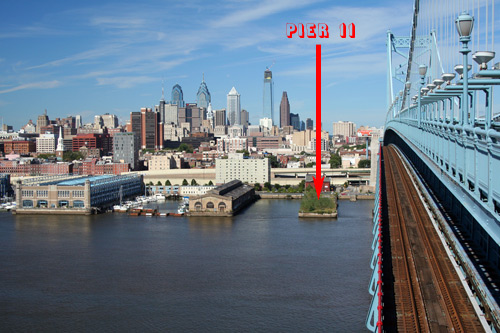
|

17 June 09: Rainbow connections
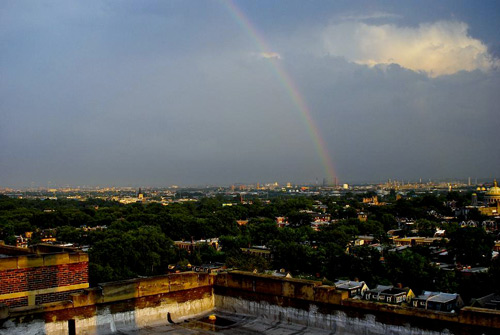
Hey now, a Philly Skyline thanks to alla yous who sent rainbow and weather pictures yesterday.
The one pictured above is by famed Phillybits author Ray Skwire (whose brother Brendan, a famed author in his own right, had a casual run-in with Arlen Specter archenemy and
über conservative Pat Toomey at a drinking liberally event that was probably my favorite Philly blog moment of 2009 so far -- see "WTF You Can Believe In" HERE). Unbeknownst to me and Ray until recently, we have a
mutual friend (yo K!) and we had planned on meeting up on Monday night.
I was getting ready to leave the house right as that storm closed in on Fishtown, and Ray was watching it roll through from the 9th floor perch they share in West
Philly. Right around the time I was scrambling to focus and get a shot before the light turned green at 30th Street Station, Ray was taking this shot looking out over
West, Southwest, and South Philly. When I arrived, he'd just finished snapping the shot of the sun illuminating the heavens beyond Cobbs Creek. You can see it and many
other great photos at his photography blog, Scene in Philly, HERE.
* * *
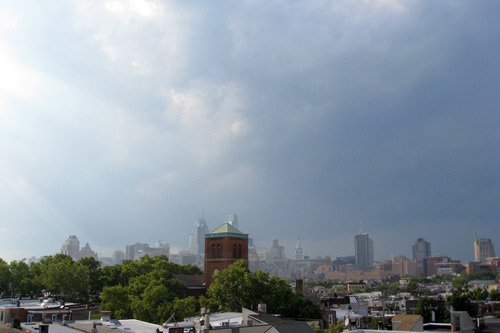
This one here looks the opposite direction from the rainbow (Monday's rainbow was mostly visible toward the southeast in Philly), but has a nice perspective of parting
of the light and dark. This is from one time It's Always Sunny caption contest winner Brandon Silverman in
Bella Vista. I told him that church steeple is pulling a Phillies Theme Tower on
his money shot, but it's a nice view all the same. He's got a lot of nice views like it (including some sunset skyline panoramas) on his Flickr, HERE.
* * *
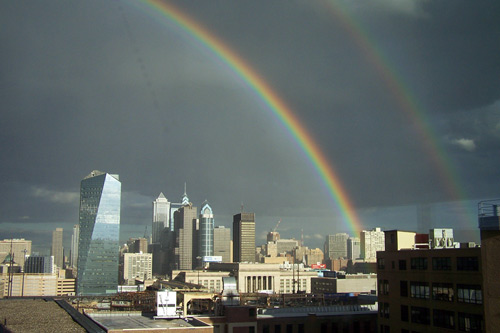
This last double rainbow here, sent in by longtime reader and current Drexel dude Stephen Roof, cheats a little bit. It's not from Monday, but from April 3. But as
they go, skyline and rainbow, it's a winner.
Nice work, guys.
–B Love
|
16 June 09: Ballpark figures
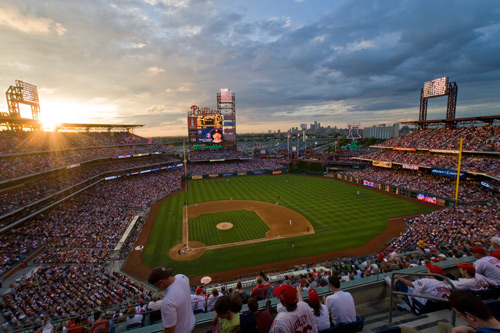
After a much needed night off, the Phillies send ace Cole Hamels to the mound tonight to kick off the series with the team Major League Baseball tried so hard to make
their rival, the Toronto Blue Jays. Cito Gaston may be back managing that team, and sourpuss Scott Rolen may be manning the hot corner for them, but beyond that, the
two teams have nothing in common. It's another pointless series the rest of the league must endure so that MLB can stroke the egos of its biggest markets with
Yankees/Mets, Cubs/White Sox and Giants/A's series. (I'm not sure there's even anyone in California that cares about the Dodgers/Angels games . . . )
But there they are, and the games count. Interleague Baseball is back, baby! Feh. At least the Phils won't have to face the best pitcher in 2009 baseball, Roy
Halladay, as he's hung up with an injury at the moment. The Phillies head to Canada next weekend after a visit to old pal Pat Burrell in his new domey digs, though, so
there's still a chance Halladay could put his 10-1 on the line against the champs.
A little over two months into the season, things are starting to shake out. Raul Ibañez has proven to be one hell of a signing and fan favorite -- he's leading
all National League outfielders in all-star votes. Chase Utley and Ryan Howard are steady mashing. Shane Victorino and Jayson Werth are giving just about what we
expect of them. Pedro Feliz and Carlos Ruiz are giving even more. Jimmy Rollins . . . well that little former MVP has got some waking up to do. Leave it up to me and
he'd be batting 7th until his average squeaks back above .250. In 279 plate appearances, the leadoff hitter has drawn 12 -- a whole dozen -- base on balls.
Chris Coste has the same amount in 91, and in 48 trips to the plate, Matt Stairs has 10.
Speaking of Stairs . . .
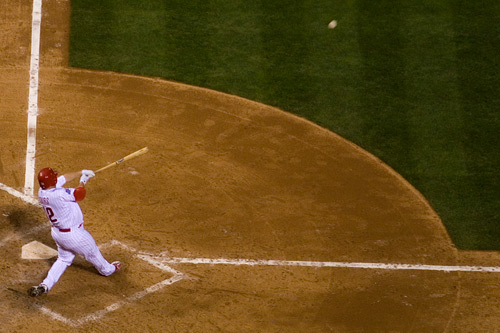
How about this guy? For being a guy who is forever written into local sports lore for a single swing of the bat, he's a pretty great weapon to have waiting in the
wings in the late innings. Use Stairs in case of emergency, as the t-shirt
says.
A little over two months into the season, the pitching staff is still trying to find its footing, and yet the Phillies are four games up on the second place Mets. You
have to think that Hamels will eventually stabilize into the playoff MVP we expect him to be, and if Ruben Amaro can add another solid arm (as much as Halladay would
be amazing, the Marquis-Oswalt tier seems more likely) to keep balance with youngsters like JA Happ and Antonio Bastardo, there's no reason it won't be another
exciting summer in South Philly. Go Phillies go!
Philly Skyline Phillies Skyline, dated Friday 12th June. 10 Rittenhouse' crane is gone, but the penthouse's showroom windows are still boarded up . . . what's up with
that? Its cousin 1706 Rittenhouse is still goin' up, and has almost matched the roofline of the Medical Tower across the street. And somewhere under that skyline,
beneath that Holiday Inn tree cover, Green Man and The Gang were reliving their World Series experience. Let's hope we can relive it with them a few months from now.
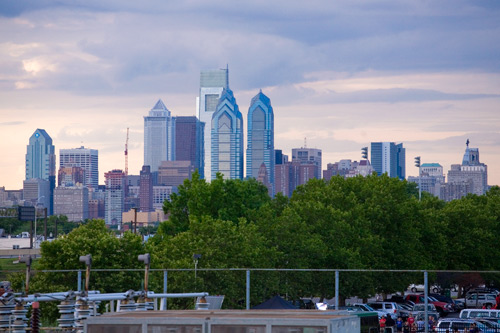
–B Love
|
16 June 09: Out West On South
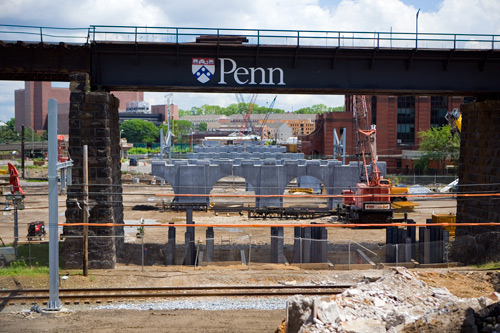
Last time we checked in on South Street Bridge, a handful of M-shaped support structures were forming
on the western end, between the expressway and Franklin Field. Two of these are now in place in the buttresses in the middle of the river, the same buttresses that
have been there since the 19th century.
The photo above is looking east to the river across what was once and will again be South Street, from its western end at Convention Avenue. In the distance,
construction on the second phase at Toll Brothers' Naval Square project thumbs its nose at the economy from behind its giant brick walls. Natalie Kostelni wrote about
this last week for the PBJ, but she called the
neighborhood 'Grays Ferry' . . . d'oh! (Again, people: just because Grays Ferry Avenue runs through G-Ho, even if you don't call it G-Ho, it does not make the
neighborhood Grays Ferry. Grays Ferry neighborhood is west of the 25th Street viaduct and south of Grays Ferry Ave, well below Washington. Just like Germantown
Avenue runs through Northern Liberties and Fairmount Avenue runs through West Philly. I digress, and I still love ya, Nat.)
Anyway, since South Street Bridge's reconstruction has been in high gear, this is the first time this web site has taken a gander from the University City end of
things. Note the sensitive placement of steel columns for the bridge's support under the freight rail high line.
This second photo, below, is panned back from a little to the left. Take a look at how the University City regional rail station ends on the SSB end; it's
still in service, but you have to exit on the southern end of the platform, in between the two parking garages on Convention Ave.
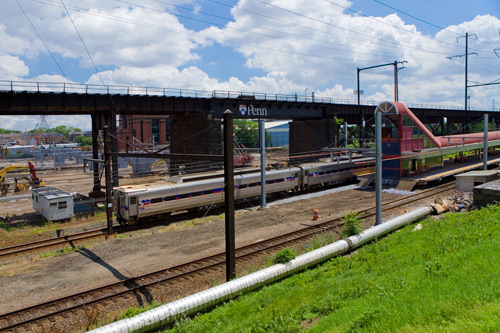
–B Love
|
16 June 09: PECO pot o' gold
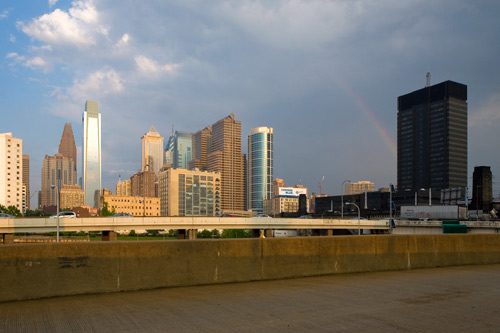
The storm that passed through last Tuesday morning was epic, an instant legend with massive rain and flooding, steady thunder, and strobe like lightning. And it was
long -- long enough for the people on their morning commute to hope it would pass, only to end up with soaking wet pants, socks and shoes, umbrella be damned.
The one that rolled through last night, though, was your regularly scheduled June thunderstorm, nothing more than a shower that's just passin' thru, 10 minutes of your
time and I'll be on my way. At 6:45 in the evening, it's the type of storm that, when it's passed but still within range, and the sun has broken through behind you, it
makes for some magic hour magic that photographers dream of. And it might even toss you a rainbow. I've seen my share of rainbows and I've photographed the skyline
just after/before a big storm, but never have I caught them together.
This here, seen above, is about as close as I've gotten, and wouldn't you know I was in a car with nowhere to park, my chance for a good shot the length of the red
light. From the 30th Street / Market Street exit of the Schuylkill Expressway, a Philly Skyline Part-Rainbow Skyline.
How about y'all? Did you get any photos of the skyline with a rainbow? If so, I'd love to see em. Drop me a note to blove AT phillyskyline DOT com with your name and
neighborhood and I'll post em with your name on the byline where it belongs.
–B Love
|

15 June 09: Monday Afternoon Lookin' Up
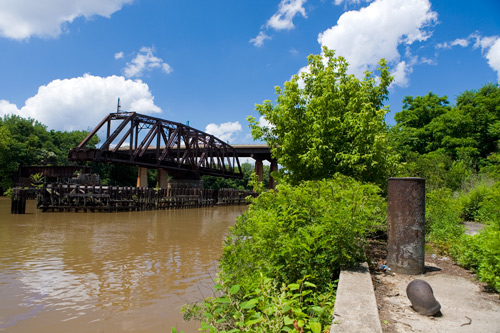
Down here under the Grays Ferry Bridge, the brown water matches brownfields on the banks, complemented by green vegetation under blue skies, and sometimes accentuated
by rainbow slicks of oil brought upstream from Sunoco with the tide. Some day soon, as early as next year, we'll have a slightly different view of this otherwise
hidden view of the hidden river. Last month, in its final act as the historic Fairmount Park Commission that voters did away with (instead merging it with the Rec
Department), the park acquired the pictured parcel of land -- called the Dupont Crescent, for the crescent of land on the Schuylkill behind the Dupont
laboratory -- and the even narrower strip of land between Locust and South Streets.
This is the foot of the same Wharton Street that 20-some blocks east drops visiting Kansans and Quebeckers in line at Pat's and Geno's. Down here in the Forgotten Bottom, it's been a favorite makeshift fishing dock for neighborhood residents for years,
tucked behind a former warehouse that's now parking ground for the Philadelphia Trolley Works. The Schuylkill River Development Corporation (SRDC) is this summer
putting out for bid a contract that will turn this thick June green into a year round, landscaped addition to the Schuylkill River Trail.
From here, it will snake three-quarters of a mile to Paul Cret's University Avenue Bridge. A half a million dollars' worth of environmental remediation has already
been completed on the site.
If it seems that the Crescent is a little disjointed, separate from the trail that runs more or less contiguously from Locust Street to Valley Forge and beyond, it's
because it is -- for now. It's part of SRDC's strategy to develop the pieces of the puzzle that will necessitate the urge to fill the gaps. Stephan Salisbury reported
in The Inquirer that a temporary
solution, after the South Street Bridge is rebuilt, will take the trail across the new bridge and down the small access road that runs parallel to the Schuylkill
Expressway to the University Avenue Bridge, from which a path will lead down to the Crescent.
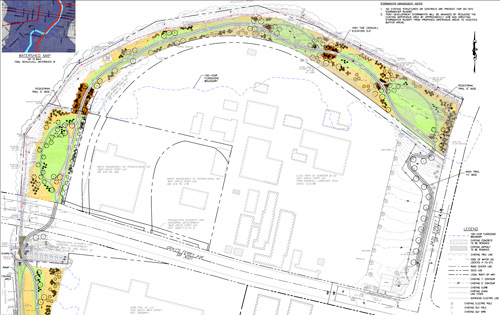
This graphic, graciously provided by Lane Fike, SRDC's Director of Capital Programs, illustrates the wide bike path winding from 34th Street (University Ave), with a
few pedestrian-only outlooks. The path winds behind the Waste Management facility and under the Grays Ferry Avenue Bridge, where the next phase of the trail will be
considered.
Bartram's Garden is on the other side of the river just downstream, and there's a railroad bridge crossing the river that runs directly next to the meadow at
Bartram's, the track leading southward right behind the garden's property. Thing is, it's active, a shared asset of Conrail and CSX, and surely CSX isn't going to want
to go through that again with the trail, nor would SRDC, who'd have to put up the fight.
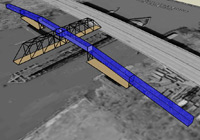 That's where, as an alternative to that rail bridge that won't happen and the bike/ped un-friendly Grays Ferry Bridge, the swing bridge is being considered as a river
crossing. "We've got a conceptual study out now to reopen it," Fike said this morning, already considering logistics beyond these two imminent phases.
That's where, as an alternative to that rail bridge that won't happen and the bike/ped un-friendly Grays Ferry Bridge, the swing bridge is being considered as a river
crossing. "We've got a conceptual study out now to reopen it," Fike said this morning, already considering logistics beyond these two imminent phases.
This incredible relic is well known to those who've been to the river (whether on a Schuylkill cruise, a kayak tour or an afternoon's fishing trip), but it still
remains largely out of view. The swing bridge has been locked in the open position since 1976, when it went dark. It was built in 1902 by the American Bridge Company
for the
Philadelphia, Wilmington and Baltimore Railroad, whose head station was at Broad & Washington. (The bridge's predecessor carried President Lincoln's body to the
station on the funeral train in 1865; PW&B was bought out by the Pennsylvania Railroad in 1916.) The Library of Congress has a nice background on the swing bridge in
the PDF HERE.
There you have it: what's coming to the Schuylkill is coming into sight. Before you know it, we'll be cruising past Sunoco on our way to Fort Mifflin and the Delaware
beyond.
–B Love
Special thanks to Lane Fike and the Schuylkill River Development Corporation for the images of Dupont Crescent and the swing bridge proposal. For more like them,
visit schuylkillbanks.org HERE.
|
15 June 09: Monday Mornin' Lookin' Up
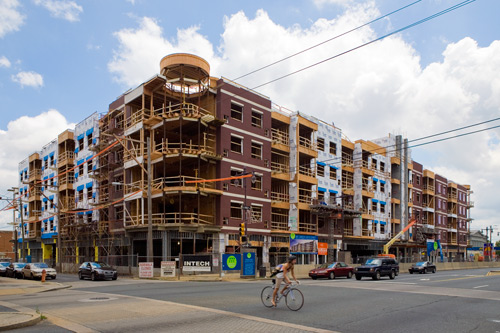
Hey hey, whattaya say? Everybody have a good weekend out there? Graduate from Drexel? Take a nice Sunday ride on Kelly Drive? Fly a kite down the shore? Odunde Odunde?
Avoid a Bosox sweep by shellacking that big baby Beckett? Whatever you did, I hope it's tucked in the good part of your short term memory, cos it's Monday now . . .
and to celebrate, Philly Skyline's gonna kick it old school with a MMLU in bite sized segments.
We begin here at Broad & Fitzwater, a stripe of a boundary between G-Ho and Hawthorn, a conduit between Center City and South Philly, searching for an Avenue of the
Arts identity of its own. 777 South Broad will especially bring an identity to the stretch between the McDonald's, Popeye's and Hess gas station (and the High School for
the Performing Arts just down the street), a nice injection of life to a stretch that could use it.
The five-story Dranoff property, designed by JKRoller, is topped off and has a good sense of what it will look like when finished -- rounded corners with balconies,
alternating brick and metal façade work, and a neo-art deco main entrance in the middle of the Broad Street block between Fitzwater and Catharine.
777 pays little attention to Dranoff's other statement on Broad Street (the big pink one that looks like an extra from Beetlejuice), and aims to achieve LEED
certification with its use of local and recycled materials. A LEED certification would be the first of its kind for a major, mixed use building in
Philadelphia.
Move-in date for the apartments at 777 South Broad is tentatively scheduled for February 2010. For more on the project, visit its web site HERE.
* * *
One more for this first thing first thing today: yesterday was Flag Day. Not to be confused with Philly
Flag Day -- that's the Philly Pride Lady's day -- this one is for all flag waving Americans, a hootenanny for Betsy Ross' star spangled banner, Old Glory's
Day. Here she is then, the red white and blue, just for you.

–B Love
|

|







